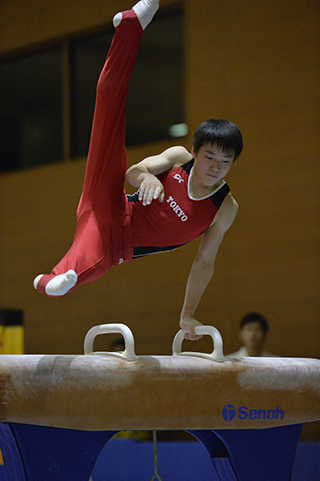Gymnastics
[Competition venue: Ariake Gymnastics Centre]
-

Overview
Gymnastics are divided into three disciplines : artistic gymnastics, rhythmic gymnastics and trampoline gymnastics.Artistic gymnastics is scored for difficulty, artistry, stability, etc. of performance on the floor, a horizontal bar or any other predetermined apparatus.
In rhythmic gymnastics, competitors perform to music using a ribbon, ball or any other hand apparatus, competing for artistry.
Trampoline gymnastics is scored for execution of routines, difficulty calculated based on the amount of somersault and twist, time of flight by measuring time spent in the air, and parallel movement on the bed.
Key Points
Artistic gymnasts have two different scores, the D score (difficulty of the routine) and the E score (execution of the routine). All gymnasts begin with a 10.0 execution score, and points are then removed for faults such as bent legs, arms and falls. Among the attractions of artistic gymnastics are acrobatic performance such as somersaults and jumping, which are specific to artistic gymnastics, and body flexibility.
Rhythmic gymnastics include both rhythmical and lively motions and delicate elegance. Sophisticated beautiful movements of the body and hand apparatus combined as one, and artistic performance to musical accompaniment are the attractions of rhythmic gymnastics. Dignified beauty in individual events and motions in perfect sync in team events are also among the appeal of rhythmic gymnastics.
In trampoline gymnastics, male competitors often reach heights of up to seven metres, providing the illusion that they may actually land on spectators. Since scores earned in the qualifying round do not carry over to the final, and finalists do only one routine, the competitor qualified to the final in 8th position has a chance to win the final, and spectators can witness thrilling competitions.
History
Gymnastics was on the ancient Olympic programme. At the time, athletics events such as rope climbing and pole vaulting were also included.
Artistic gymnastics has been contested since the Athens 1896 Olympic Games. Initially, only men's competitions were contested. At the Amsterdam 1928 Olympic Games, women's artistic gymnastics was introduced for the first time as an exhibition sport.
Although gymnasts had competed for a total of scores earned in “compulsory exercises” and “optional exercises,” compulsory exercises were eliminated after the Atlanta 1996 Olympic Games, and gymnasts currently perform only perform optional exercises.As for rhythmic gymnastics, individual events have appeared since the Los Angeles 1984 Olympic Games, and team events since the Atlanta 1996 Games.
Trampoline gymnastics was introduced as new gymnastics events at the Sydney 2000 Olympic Games.
Detail
Event Men Women Artistic Team competition
Individual All-Around competition
Floor Exercise
Pommel Horse
Rings
Vault
Parallel Bars
Horizontal BarTeam competition
Individual All-Around competition
Floor Exercise
Uneven Bars
Beam
VaultRhythmic Individual All-Around competition
Group All-Around competitionTrampoline Individual competition Individual competition
(Updated on April 10, 2019)

